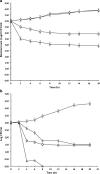Enhanced bactericidal effect of enterocin A in combination with thyme essential oils against L. monocytogenes and E. coli O157:H7
- PMID: 25829595
- PMCID: PMC4375200
- DOI: 10.1007/s13197-013-1214-5
Enhanced bactericidal effect of enterocin A in combination with thyme essential oils against L. monocytogenes and E. coli O157:H7
Abstract
The combined effects of enterocin A with Thymus vulgaris essential oils (EOs) against Listeria monocytogenes and Escherichia coli O157:H7 were investigated in vitro by enumeration of surviving populations of testing pathogens and minimal inhibitory concentration (MIC) determination. Enterocin A was purified to homogeneity by RP-HPLC from the culture fluid of Enterococcus strain and thyme EOs were extracted from local Thymus vulgaris plants. The major constituent of thyme EOs oils determined by GC-MS was thymol (78.4 %). Combination of enterocin A with thyme EOs showed an enhanced bactericidal effect against Listeria monocytogenes. Checkerboard assay and isobologram construction displayed a synergistic interaction between these compounds against Listeria (FIC index <0.5). Moreover, the MIC value of enterocin A has fallen fivefold (from 4.57 to 0.9 μg/ml), while the MIC of thyme EOs decreased threefold (from 3.6 to 1.2 μg/ml). Treatments with enterocin A alone did not affect the growth of the enteric pathogen E. coli O157:H7. However, the addition of thyme EOs and enterocin A yielded a synergistic antimicrobial effect against E. coli (MIC thyme EOs decrease from 2.2 to 0.71 μg/ml). This is the first report on the combined effect of enterocin A and thyme EOs against food pathogen bacteria. This combination could be useful in food bio-preservation.
Keywords: Bacteriocins; E. coli; Essential oils; Food preservation; Lactic acid bacteria; Listeria.
Figures




Similar articles
-
Novel strategies of essential oils, chitosan, and nano- chitosan for inhibition of multi-drug resistant: E. coli O157:H7 and Listeria monocytogenes.Saudi J Biol Sci. 2022 Apr;29(4):2582-2590. doi: 10.1016/j.sjbs.2021.12.036. Epub 2021 Dec 17. Saudi J Biol Sci. 2022. PMID: 35531141 Free PMC article.
-
Synergistic Antimicrobial Activities of Combinations of Vanillin and Essential Oils of Cinnamon Bark, Cinnamon Leaves, and Cloves.Foods. 2021 Jun 17;10(6):1406. doi: 10.3390/foods10061406. Foods. 2021. PMID: 34204542 Free PMC article.
-
The antimicrobial efficacy of plant essential oil combinations and interactions with food ingredients.Int J Food Microbiol. 2008 May 10;124(1):91-7. doi: 10.1016/j.ijfoodmicro.2008.02.028. Epub 2008 Mar 4. Int J Food Microbiol. 2008. PMID: 18378032
-
An Update on Effectiveness and Practicability of Plant Essential Oils in the Food Industry.Plants (Basel). 2022 Sep 22;11(19):2488. doi: 10.3390/plants11192488. Plants (Basel). 2022. PMID: 36235353 Free PMC article. Review.
-
Potential of Essential Oils in the Control of Listeria monocytogenes.Microorganisms. 2023 May 23;11(6):1364. doi: 10.3390/microorganisms11061364. Microorganisms. 2023. PMID: 37374865 Free PMC article. Review.
Cited by
-
A Focused Insight into Thyme: Biological, Chemical, and Therapeutic Properties of an Indigenous Mediterranean Herb.Nutrients. 2022 May 18;14(10):2104. doi: 10.3390/nu14102104. Nutrients. 2022. PMID: 35631245 Free PMC article. Review.
-
Production of Recombinant Antimicrobial Polymeric Protein Beta Casein-E 50-52 and Its Antimicrobial Synergistic Effects Assessment with Thymol.Molecules. 2017 May 31;22(6):822. doi: 10.3390/molecules22060822. Molecules. 2017. PMID: 28561787 Free PMC article.
-
Antimicrobial Activity of Probiotic Bacteria Isolated from Plants: A Review.Foods. 2025 Feb 4;14(3):495. doi: 10.3390/foods14030495. Foods. 2025. PMID: 39942088 Free PMC article. Review.
-
Potential Impact of Combined Inhibition by Bacteriocins and Chemical Substances of Foodborne Pathogenic and Spoilage Bacteria: A Review.Foods. 2023 Aug 20;12(16):3128. doi: 10.3390/foods12163128. Foods. 2023. PMID: 37628127 Free PMC article. Review.
-
A Systematic Review of Plants With Antibacterial Activities: A Taxonomic and Phylogenetic Perspective.Front Pharmacol. 2021 Jan 8;11:586548. doi: 10.3389/fphar.2020.586548. eCollection 2020. Front Pharmacol. 2021. PMID: 33488385 Free PMC article. Review.
References
-
- Bagamboula CF, Uyttendaele M, Debevere J. Inhibitory effect of thyme and basil essential oils, carvacrol, thymol, estragol, linalool and p-cymene towards Shigella sonnei and S. flexneri. Food Microbiol. 2004;21:33–42. doi: 10.1016/S0740-0020(03)00046-7. - DOI
-
- Bamoniri A, Ebrahimabadi AH, Mazoochi A, Behpour M, Kashi FJ, Batooli H. Antioxidant and antimicrobial activity evaluation and essential oil analysis of Semenovia tragioides Boiss from Iran. Food Chem. 2010;122:553–558. doi: 10.1016/j.foodchem.2010.03.009. - DOI
-
- Borrero J, Kunze G, Jiménez JJ, Böer E, Gútiez L, Herranz C, Cintas LM, Hernández PE. Cloning, production and functional expression of the bacteriocin enterocin A, produced by Enterococcus faecium T136, by the Yeasts Pichia pastoris, Kluyveromyces lactis, Hansenula polymorpha and Arxula adeninivorans. Appl Environ Microbiol. 2012;78:5956–5961. doi: 10.1128/AEM.00530-12. - DOI - PMC - PubMed
LinkOut - more resources
Full Text Sources
Other Literature Sources
Miscellaneous
